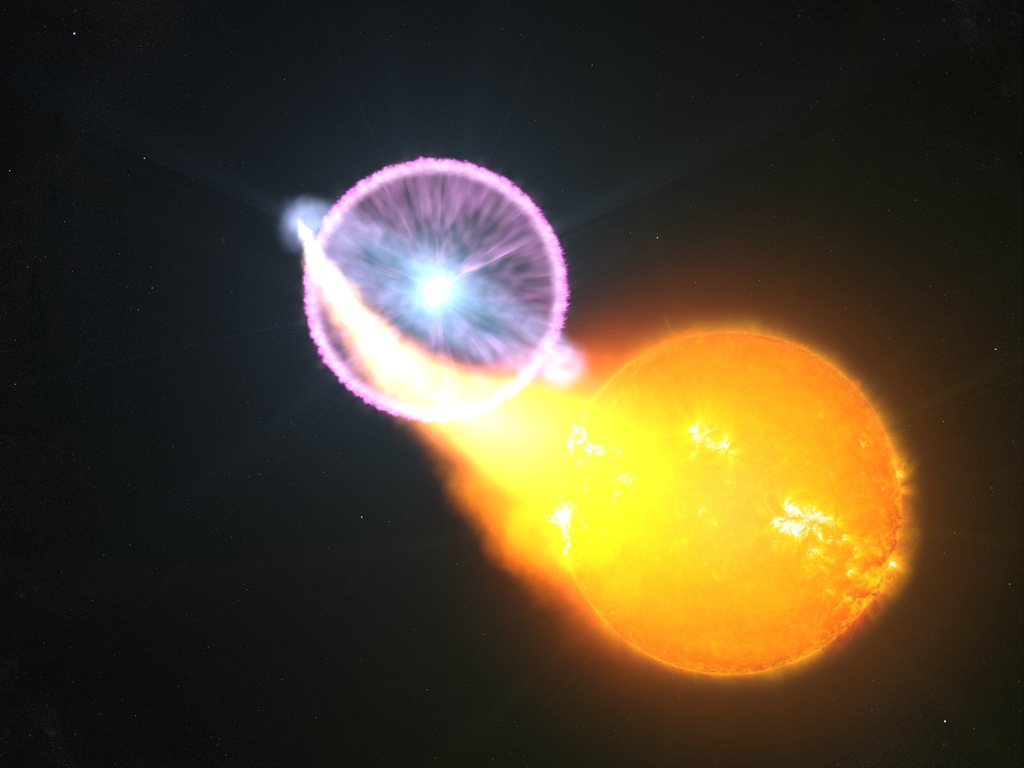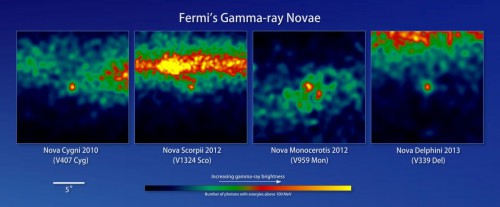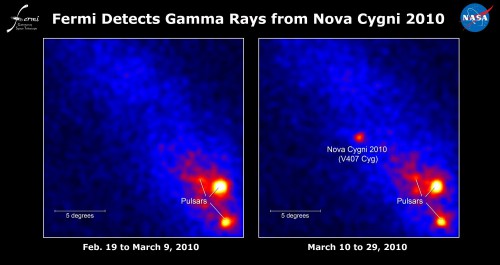
The study of cosmic gamma ray sources is one of the most productive research fields in astrophysics, allowing scientists to uncover the extreme physical processes of the high-energy Universe. A series of space telescopes launched in recent years, in order to observe in the sky in gamma ray wavelengths, has helped astronomers to shed new light on the exotic physics of the most energetic objects in the Universe, like quasars, neutron stars, blazars, and supermassive black holes in the centers of galaxies. Now a series of observations made with NASA’s Fermi Space Telescope in recent years comes to reveal a new and improbable source of gamma rays in the Universe: the inconspicuous novae in binary star systems.
Launched in 2008, the Fermi Space Telescope observes the Universe in X-ray and Gamma-ray wavelengths between 8 KeV and 300 GeV from its orbit of 550 km above the ground. With the help of its two science instruments, the GLAST Burst Monitor, or GBM, and the Large Area Telescope, or LAT, Fermi has been instrumental in the study of extremely energetic astrophysical phenomena. Some of Fermi’s exciting findings include the discovery of high-energy cosmic rays bursts coming from supernova remnants, gamma ray flares from active galactic nuclei, or blazars, gigantic gamma-ray bubbles in the Milky Way galaxy extending thousands of light-years into space, and the discovery of intriguing evidence for the existence of dark matter at its center. In addition, Fermi has also studied hundreds of white dwarfs and pulsars, while also discovering dozens of new such objects during its five-year mission.

When low- and medium-mass stars, up to approximately eight solar masses, exhaust the hydrogen in their core during the last stages of their lives, they begin to collapse under their own weight, while at the same time their outer layers start to expand. At a certain point, when temperatures and pressures are sufficiently high, the core begins to fuse helium into heavier elements like carbon and oxygen, leading to a huge inflation of the star which evolves to become a red giant. This carbon-oxygen fusion cycle inside the core forces the red giant to eventually blow off its outer layers into space, to form a planetary nebula. The burned-out collapsed core that remains behind becomes a white dwarf, with all its mass compressed into a sphere the size of Earth. Supported only by the degenerate pressure of the tightly packed together electrons in their interior, these stellar corpses can no longer sustain thermonuclear fusion reactions, and they spend the remainder of their lives slowly radiating away their thermal energy before eventually cooling down to become black dwarfs.
Although some white dwarfs appear in isolation, most are members of binary and multiple star systems that are bound together by gravity. In the cases where a white dwarf’s stellar companion is a red giant or a main sequence star, the former’s intense gravity will steadily accrete matter from the latter, forming an accretion disk of material that eventually falls onto the surface of the white dwarf. When the temperature and pressure of this infalling material, which mostly consists of hydrogen and helium, reaches a critical point, the white dwarf’s surface ignites, leading to runaway thermonuclear explosions on its surface that eject almost all of the accreted material into space, at speeds of several thousand miles per second, causing the star to flare up. This resulting sudden brightening, which can last from a few days to a few years, is called a nova. Even though each novae explosion can release up to 100,000 times the Sun’s annual energy output, while shinning brightly at visible wavelengths, current theoretical models predict that novae aren’t powerful enough to produce gamma rays, which are the most energetic form of light. Yet a series of observations in recent years, conducted with NASA’s Fermi Space Telescope, has shown that, contrary to theoretical predictions, novae can indeed be powerful gamma ray sources.
The first such observations were made in March 2010, when Fermi detected unexpected gamma ray emissions coming from V407 Cygni, a nova that had just been discovered at the time in visible wavelengths by Japanese astronomers and was located approximately 8,800 light-years away. Following the nova’s initial flare up in visible light, Fermi detected a flux of gamma rays with energies greater than 100 MeV which lasted for two weeks. Initially, astronomers thought that V407 Cygni, a so-called symbiotic nova, was unique because it was enveloped in the material that was expelled from its pulsating red giant companion. A possible explanation, proposed at the time in order to account for the Fermi observations, was that the gamma rays emitted by V407 Cygni were the result of multiple shock waves from the nova’s explosions hitting at the dense enveloping material of its red giant companion.

Now, a new study that was published in the Aug. 1 edition of the journal Science comes to further strengthen the case for novae as standard gamma ray sources, detailing a new set of Fermi observations of gamma ray emissions from three newly detected novae whose companions are main sequence stars. “We initially thought of V407 Cygni as a special case because the red giant’s atmosphere is essentially leaking into space, producing a gaseous environment that interacts with the explosion’s blast wave,” says Dr. Steven Shore, a professor of astrophysics at the University of Pisa in Italy and co-author of the study. “But this can’t explain more recent Fermi detections because none of those systems possess red giants.” The first two novae, V959 Mon and V1324 Sco, were detected by Fermi’s onboard LAT instrument in June 2012, and the third, V339 Del, in August 2013 during the space telescope’s all-sky survey. As with V407 Cygni, following their initial flare up in visible wavelengths, the newly discovered novae emitted high-energy gamma rays for weeks, which in the case of V339 Del lasted 27 days. “There’s a saying that one is a fluke, two is a coincidence, and three is a class, and we’re now at four novae and counting with Fermi,” says Teddy Cheung, an astrophysicist at the Naval Research Laboratory in Washington, D.C., and lead author of the study.
Yet, despite sharing similar characteristics with V407 Cygni, the gamma ray emissions of the three new novae must result from an entirely different process. The latter are accreting material from ordinary, main sequence stars which means that, contrary to V407 Cygni, the exploding nova material is dissipated directly into space. Cheung’s team hypothesizes that the explosions from these novae create a series of shock waves that propagate through the interstellar medium at different speeds, with the faster ones eventually smashing into the slower ones. This process, according to the researchers, could accelerate charged particles in the expanding material at high enough energies in order to produce gamma rays. Yet the study’s team is quick to point out that, at this point, the exact mechanism that produces these gamma ray emissions remains unknown, underscoring the need for additional observations. “This was a completely unexpected discovery and we still don’t understand the cause,” says Dr. Summer Starrfield, a computational astrophysicist at the Arizona State University’s School of Earth and Space Exploration and co-author of the recent study. “No one suspected novae were violent enough to be emitting at these very high energies … We are puzzled and ongoing studies of possible causes are underway via computer modeling of the events. This exciting discovery is telling us something important about the explosions of classical novae but we don’t, as yet, know what it means.” Even though the answer to the exact cause of these gamma ray emissions currently eludes astronomers, Fermi’s findings nevertheless hint at the possibility of most novae in the galaxy being similar gamma ray sources. “Because the gamma ray properties of the novae detected so far by the Fermi-LAT appear similar to one another, and their underlying properties are unremarkable, it appears all novae can be considered to be candidate gamma ray emitters,” concludes Cheung’s team. “Their detection by the LAT may imply close proximity and that other optical novae not yet detected with the LAT are more distant and have fainter optical peaks.”
The unexpected discovery of gamma ray emissions from stellar objects such as novae, which were previously thought to be not powerful enough to produce them, provides new clues regarding the evolution and overall properties of these fascinating members of the stellar zoo, while reminding us that the Universe is filled with exciting and tantalising mysteries at every turn.
Artist’s rendering of nova V407 orbiting its red giant companion star. Gamma rays (magenta) arise when accelerated particles in the explosion’s shock wave crash into the red giant’s stellar wind. Video Credit: NASA/Goddard Space Flight Center/ Conceptual Image Lab
Want to keep up-to-date with all things space? Be sure to “Like” AmericaSpace on Facebook and follow us on Twitter: @AmericaSpace



